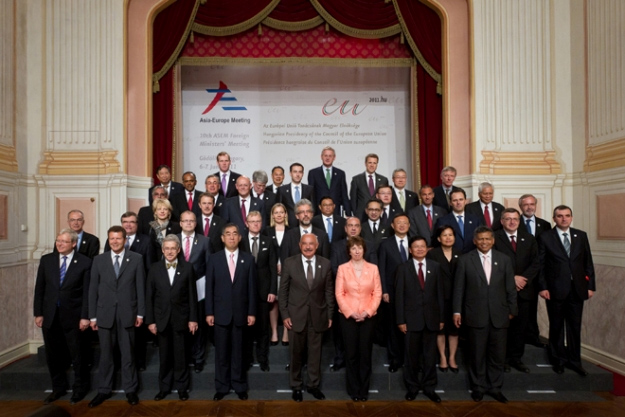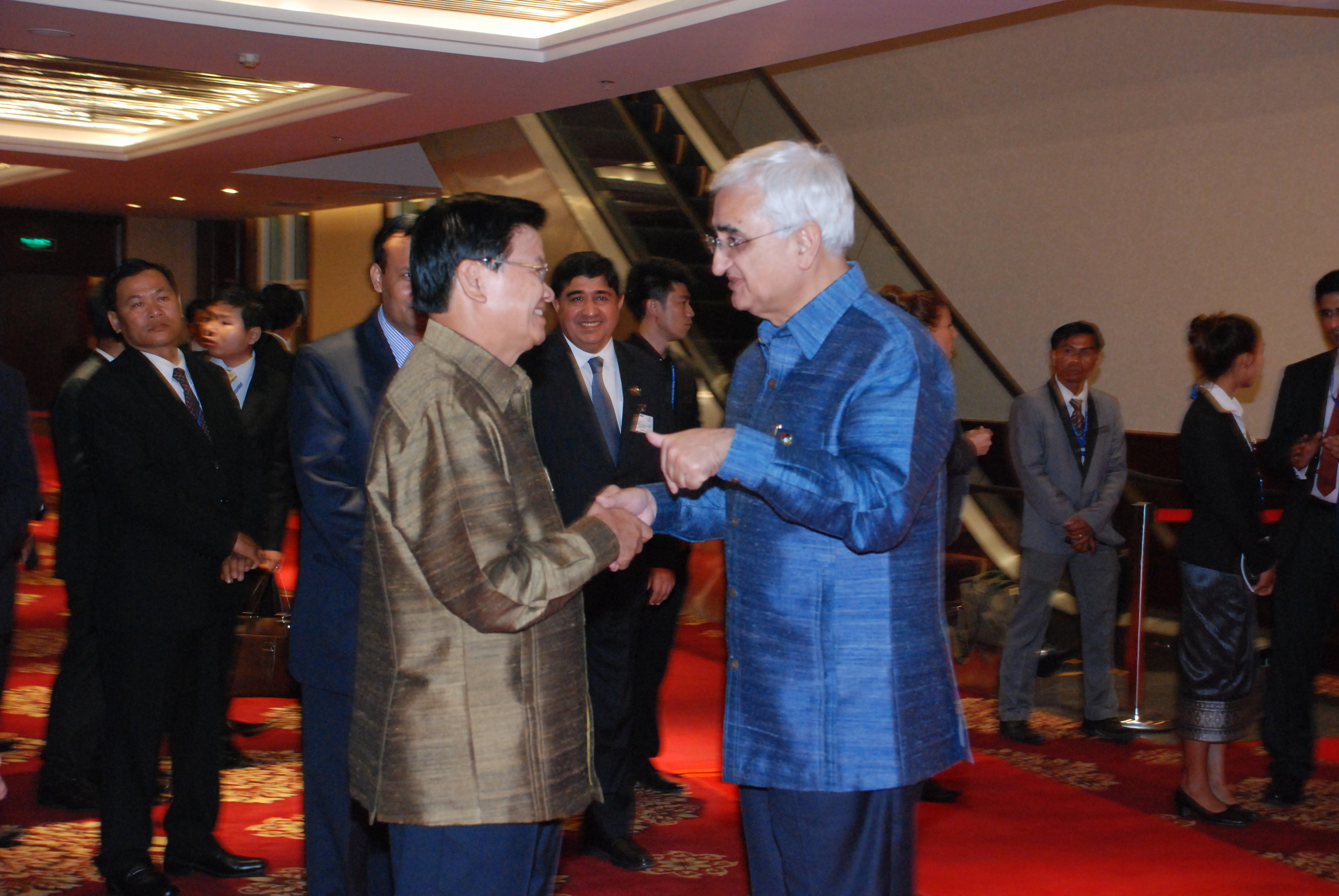By Archis Mohan
The ASEM (Asia-Europe Meeting) foreign ministers will gather in New Delhi on November 11 and 12 with an agenda more ambitious than any the 17-year-old grouping has had on its table since it was founded in 1996.
Its challenge, to paraphrase External Affairs Minister Salman Khurshid’s succinct speech at the last ASEM Summit meeting in Vientiane in 2012, being how to preserve the grouping’s informality as the only of its kind dialogue forum to discuss a wide gamut of issues between Asia and Europe but also reinvigorate the platform to achieve tangible results.
Observers of international politics the world over would keenly track the discussions at the 11th ASEM Foreign Ministers Meeting (ASEM FMM11) to see if Asia and Europe can come together to revitalise the forum and make it a more result oriented platform without taking away from its intrinsic democracy. The meeting is expected to pave the path to an ASEM that its partners want to emerge re-strengthened at its next summit meeting in Brussels in 2014, and as it approaches its 20th anniversary celebrations in 2016.
The ASEM currently has 51 partners.It should be “These include 49 Asian and European countries and two International Organisations – the ASEAN Secretariat and the European Commission”. It is the only Asia-Europe region-to-region platform to discuss policy dialogue on political, economic, social and cultural issues. It has, therefore, also been termed the “new Silk Road” between the two continents.
The ASEM, unlike most other regional groupings, has no secretariat. Its only physical institution is the Singapore based Asia-Europe Foundation (ASEF) that works to promote mutual understanding and cooperation between Asia and Europe through people to people exchanges, cultural contacts and seminars on the subjects of mutual political and economic interest.
 Tenth ASEM Foreign Ministers Meeting in Budapest, Hungary in June 2011
Tenth ASEM Foreign Ministers Meeting in Budapest, Hungary in June 2011
ASEM: A Vibrant and Democratic Forum
The ASEM, in the absence of a permanent secretariat, relies heavily on regular meetings between its stakeholders. The ASEM Summit meetings take place once in two years where the leaders agree upon an agenda to be implemented in the interregnum. The next ASEM Summit meeting, its 10th, is scheduled to be held in Brussels in 2014.
But ASEM remains a vibrant platform between summits. It holds 50 ministerial and officials’ dialogues every year. These cover finance, trade, culture, education, disaster preparedness, transport, immigration, climate change, piracy at sea, information technology, food security, development, employment, energy security, global governance and many more subjects.
ASEM is characterised by its informality as an open forum based on interactive sessions where all issues of mutual interest can be raised. The forum allows for putting of a multi-dimensionality of issues on the discussion table. ASEM’s basic tenet is an emphasis on equal partnership with no “aid-based” relationship between members. It focuses not just on high level meetings but also people to people contacts
However, many members believe some of the grouping’s strengths like its openness to take up myriad issues has hindered efforts to find common grounds which can then be pursued in the shape of policy frameworks. But that is in no way an indication that members doubt the current and future relevance of the forum as seen in the increase of members from 26 in 1996 to 51 currently.
A Fresh Approach
In this backdrop, ASEM partners have supported host India’s suggestion that the forum required a fresh approach for restructuring and reorienting its discussions. India’s suggestions to reinvigorate the grouping have been received well by the ASEM members at the ASEM Senior Officials’ Meeting (SOM) at Delhi NCR from September 3-5, 2013.
The SOM started the process of identifying the set of issues, wherein ASEM members would form smaller groups of five-six countries as co-sponsors to specific initiatives for enhancing cooperation between the ASEM countries. This new format of cooperation would also add more relevance to the theme for ASEM FMM11, “ASEM: Bridge to Partnership for Growth and Development” that was proposed by India and welcomed by rest of the ASEM members. These initiatives, to be finalised at an SOM meeting on November 9-10 in Delhi, would then be announced at the ASEM FMM11 and will await the nod from ASEM leaders at the next ASEM Summit Meeting.
India and ASEM
 Prime Minister Dr. Manmohan Singh at the 7th ASEM Summit, Beijing, 2008
Prime Minister Dr. Manmohan Singh at the 7th ASEM Summit, Beijing, 2008
India joined ASEM in 2007 attended its seventh Summit in Beijing in 2008 where Prime Minister Dr. Manmohan Singh led the Indian delegation. India has come to be an important member of the grouping and plays a significant role in the functioning of ASEF. The eighth ASEM Summit was held in Brussels on 4-5 October 2010 where Vice President M. Hamid Ansari led the Indian delegation.
External Affairs Minister Salman Khurshid represented India at the ninth ASEM Summit held in Vientiane, Lao PDR from November 5-6, 2012. In his speech, Mr. Khurshid set out India’s hopes and expectations from ASEM. He said ASEM needed a more focussed approach towards terrorism, maritime security, issues of food and energy security.
 External Affairs Minister Salman Khurshid being welcomed by Lao PDR’s Deputy PM and Foreign Minister Dr. Thonglun Sisoulith at the gala dinner hosted by Lao PDR’s President during the 9th ASEM Summit in Vientiane in November 2012
External Affairs Minister Salman Khurshid being welcomed by Lao PDR’s Deputy PM and Foreign Minister Dr. Thonglun Sisoulith at the gala dinner hosted by Lao PDR’s President during the 9th ASEM Summit in Vientiane in November 2012
Mr. Khurshid said ASEM had the “unique capacity” to work on areas of relevance for developing countries and emerging markets and work to make the global framework for economic governance more effective given its varied participation consisting of emerging market economies, developed and developing countries. “It is here that ASEM as a forum for dialogue and cooperation between Asia and Europe remains fundamentally relevant and can add substantive value,” said the minister.
The Minister also underlined how ASEM needed to “to orient itself definitively in a direction that facilitates, accelerates and makes possible such cooperation. This, to my mind, is perhaps the most relevant issue on the agenda of ASEM, i.e. “The Future Direction of ASEM”. He said the forums partners should “accelerate its evolution towards making ASEM the inter-Continental bridge that it was meant to be, bringing together the strengths and capacities across our countries to contribute to global growth and development, peace and stability”.
An Economic Bridge between Europe and Asia
Europe faced an economic tailspin when ASEM heads of states met in Beijing in 2008. European countries had then requested Asia to help the Eurozone economies through the financial crisis. Asia responded. European exports to Asia helped Europe come out of the crisis. Five years hence the economic situation is much different. The ASEM foreign ministers would meet in Delhi at a time when the industrialised Europe has witnessed better growth compared to emerging markets like India and ASEAN countries whose economies have slowed down. It is time that Europe pitches in to help economic recovery in emerging markets.
This is where ASEM would need to play a role in bringing business leaders and policy makers from the two sides to have regular exchanges, particularly before the 2014 Summit. These meetings have remained ignored in the last few years. According to ASEM website, senior ASEM economic officials last met in Rotterdam in 2006.
The two sides will also look at concluding negotiations on Free Trade Agreements. A comprehensive EU-South Korea FTA is in place since 2011. Negotiations with countries like Japan, Singapore, India, Vietnam, Malaysia and Thailand are at various stages. Meanwhile, Asian countries are busy putting into place the Regional Comprehensive Economic Partnership (RCEP) linking all leading economies in Asia.The EU and Asian members of ASEM have a current trade of nearly Euros 900 billion. European companies are leading investors in Asia. In 2010, 17.2% of EU outward investment went to Asia.
According to the ASEM website, in 2012 Asia’s share of all EU imports was 29.8% and 21.4% of exports. Four Asian countries are amongst the EU’s top ten trading partners, with China (12.5%) at the very top, followed by Japan (3.4%), India (2.2%), South Korea (2.2%) and Singapore (1.5%).
Currently, ASEM represents 60 percent of world’s population, 52 percent global GDP and nearly 68 percent of its trade.Archis Mohan is Foreign Policy Editor at StratPost.com.
(The views expressed above are the personal views of the writer)
*
ASEM Factsheet
ASEM founded in 1996 with 26 members
Current members 51
Members: 27 EU member states, 2 European countries, the European Commission, 20 Asian countries and the ASEAN Secretariat ASEM dialogue addresses political, economic and cultural issues
India became a member in 2007
ASEM represents 60% of world’s population, 52% global GDP and nearly 68% of its trade
Trade between EU-Asian members of ASEM is Euros 900 billion
The ASEM process includes various forum offshoots. These are:
- Asia-Europe Business Forum (AEBF)
- Asia-Europe Parliamentary Partnership Meeting (ASEP)
- Asia-Europe Peoples’ Forum (AEPF)
- ASEM Eco-Innovation Center (ASEIC)
*
Links
- ASEM website

- Statement by External Affairs Minister S.M. Krishna at the ASEM Foreign Ministers Meeting10 (ASEM FMM10) June 7-10 at Budapest
 [15.75 KB]
[15.75 KB] - Address by External Affairs Minister Salman Khurshid at the 9th ASEM Summit Plenary Session V: future Direction of ASEM at Vientiane, Lao PDR on November 06, 2012

- Address by External Affairs Minister Salman Khurshid at the 9th ASEM Summit Plenary Session II: Global Issues at Vientiane, Lao PDR on November 6, 2012

- Prime Minister Manmohan Singh’s intervention at the working lunch of the Seventh ASEM Summit in Beijing on October 25, 2008

- Address by Vice President M. Hamid Ansari at the Eighth ASEM Summit in Brussels on October 4, 2010

*